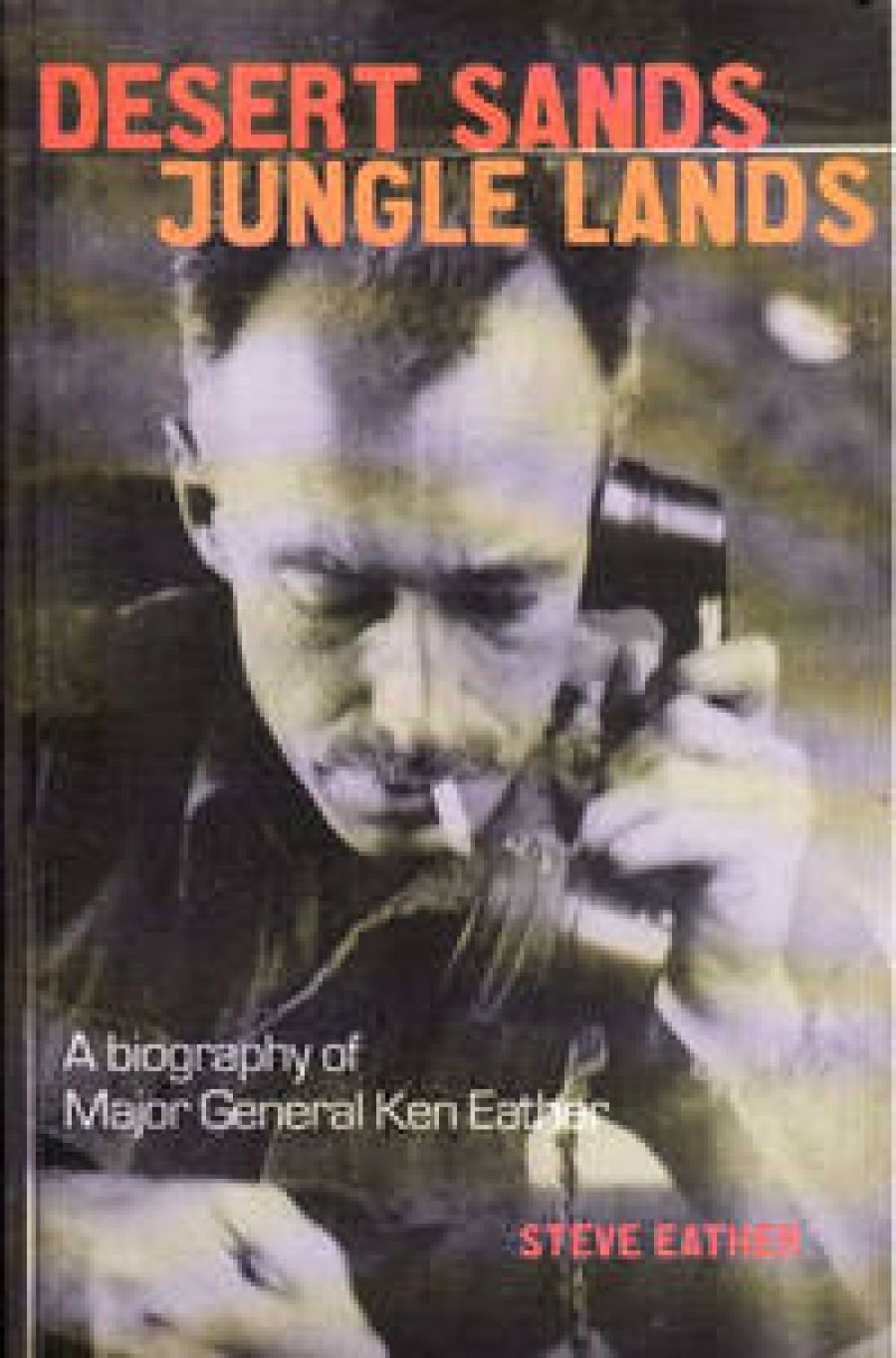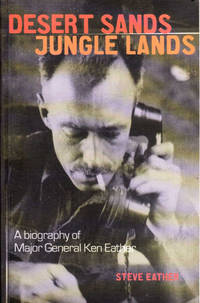
- Free Article: No
- Contents Category: Military History
- Review Article: Yes
- Article Title: It’s Now or Never
- Online Only: No
- Custom Highlight Text:
Australian historians of World War II are fast running out of time. Although printed and photographic records are more accessible than ever, the number of eyewitnesses to the war’s events is dwindling. Rescuing veterans’ insights and memories from oblivion is a matter of ‘now or never’. The subject of this book, the late Major General Ken Eather, will not be forgotten. His name will always be associated with the fighting for Bardia, Lae and Kokoda. More fragile are the invaluable recollections that living veterans have of his career and personality.
- Book 1 Title: Desert Sands, Jungle Lands
- Book 1 Subtitle: A biography of Major General Ken Eather
- Book 1 Biblio: Allen & Unwin, $35pb, 233pp
- Book 1 Cover Small (400 x 600):

- Book 1 Cover (800 x 1200):

Ken Eather’s pre-war civilian life was for the most part as unremarkable as that of thousands of the soldiers who would serve under him. He left school at fourteen, and became a dental mechanic. Atypically, he was simultaneously developing the skills and reputation of a fine part-time soldier. Born in 1901, he was too young to enlist in the First AIF, but, when the Second was raised, he was so highly regarded as a Militia officer that he was given the prestigious command of the first infantry battalion enlisted, the 2/1st Battalion. Steve Eather treats this period of Ken’s life rather briefly. Unfortunately, we do not learn much about the qualities that made him so effective in the interwar years, or of the struggles between militia and permanent army officers, which were central to the early days of the Second AIF. His personal life also receives rather short shrift: his wife is introduced without any discussion of her background or character.
Eather commanded the 2/1st with distinction in North Africa. At Bardia, the Second AIF’s first battle, he personally oversaw the detonation of Bangalore torpedoes in the enemy wire when the attack was delayed, and calmly stayed in the resultant gap, apparently oblivious to enemy fire as he directed troops with his walking stick. For his work at Bardia, he received the DSO. Steve Eather tells this story authoritatively and with a clarity that marks his descriptions of military operations throughout the book.
After the Libyan campaign, illness saved Eather from the catastrophe in Greece, and he was appointed to command the 25th Brigade of the 7th Division. This command was central to his career. In 1942 he took the 25th to Papua as the battle on the Kokoda Track was reaching crisis point. Some readers will not agree with Steve Eather’s assessment that by then the Japanese had achieved a major strategic victory over the 21st Brigade. Eather’s period of command on the Track is well covered here, although the account is perhaps a little too dependent on Ken’s diary.
Steve Eather reproduces many extracts from the general’s diaries and letters. Their style is not as interesting as that of Vasey or Potts, but they give valuable insights into the Australian experience, especially the key events of late 1942.
Eather’s interpretation of the relationship between Generals Allen, Blamey and MacArthur casts the latter pair as villains, and Ken Eather’s friend Allen as a martyr. Eather’s aggressive approach later earned him the nickname ‘Phar Lap’, but, after persuading Allen to permit a withdrawal from Ioribaiwa to Imita Ridge, he came close to being nobbled like his namesake and several other Australian generals. Instead, he played a key role in the ensuing advance and victory. Significant in that victory was the battle of encirclement at Oivi-Gorari, for which General Vasey usually gets the credit. The author needs to clarify his interpretation of Vasey’s role, for here it appears to be Eather’s battle.
This quibble relates to a broader omission. Eather’s style of command is not explained in detail. It would now be difficult to explore the mechanics of decision-making at his headquarters, but the author probably should have drawn on the brigade war diaries and other records.
Steve occasionally inflates the importance of Eather’s achievement. The implication that Hitler sent Rommel to North Africa because of the fall of Bardia is drawing a very long bow; and the suggestion that Gona had to be taken quickly to prevent a new Japanese offensive seems unlikely. The campaigns of 1943 and 1945 are neglected topics in our military history. Regrettably, the author does not devote more space to the brigadier’s role in the Ramu Valley and Balikpapan operations.
The concluding chapters are strong. As the last Australian general appointed in the war, Eather took command of the 11th Division in the final weeks of the conflict. He did a fine job administering not only his division but also the 100,000 Japanese prisoners who came into his hands on New Britain. He thus managed to stifle a bitter hatred that campaigns against the Japanese had inspired in him. This detestation is one of several traits that Steve Eather depicts as foibles in his namesake. For example, he does not shy away from assessing the exhausted brigadier’s performance at Gona as below par.
The chapter on Eather’s return to civil life is a moving one. Red tape became more important to the ex-general than red tabs, as he became frustrated by his parsimonious treatment by various governments. He personally remained unassuming, energetic and compassionate. The author finishes with a poignant triptych of the young militia officer helping his men push a water cart through pre-war Sydney streets, the brigadier sleeping beside the Kokoda Track with his men, and the retired general delivering groceries to supplement his modest family income. He was a model major general, and a model of the Australian citizen soldier.


Comments powered by CComment